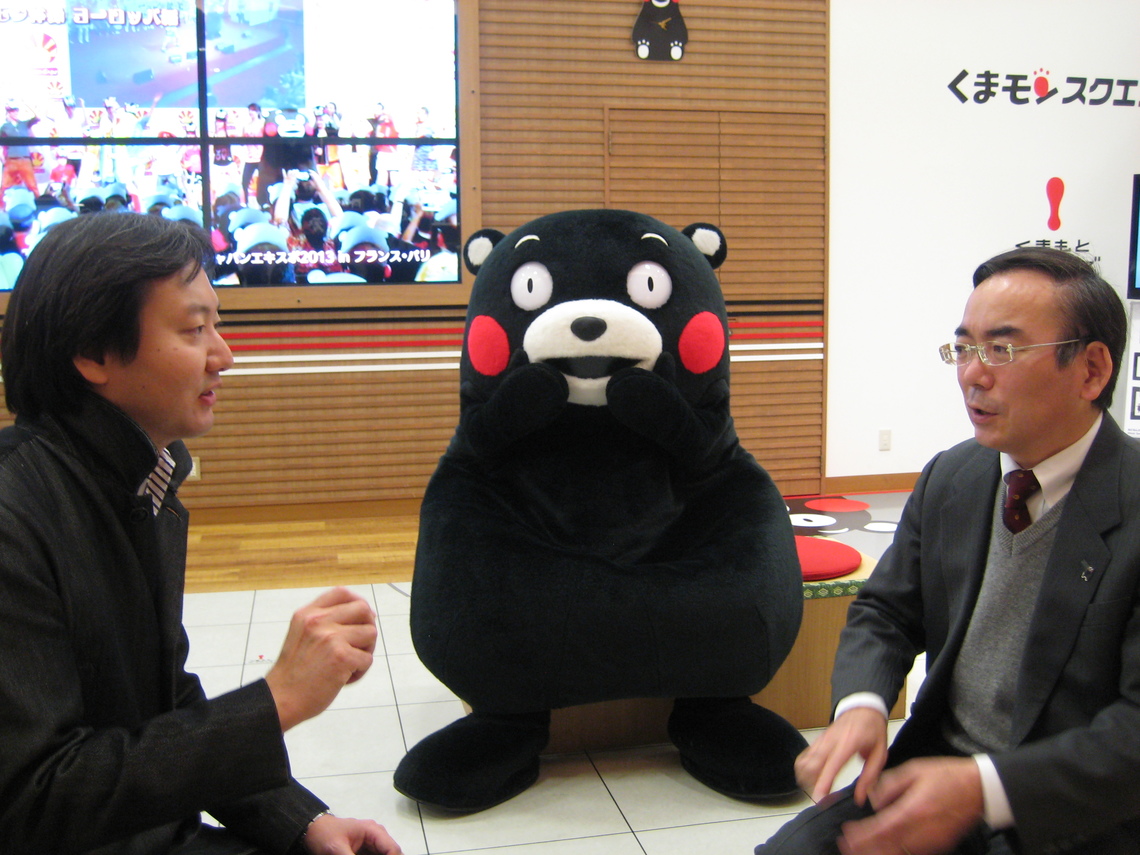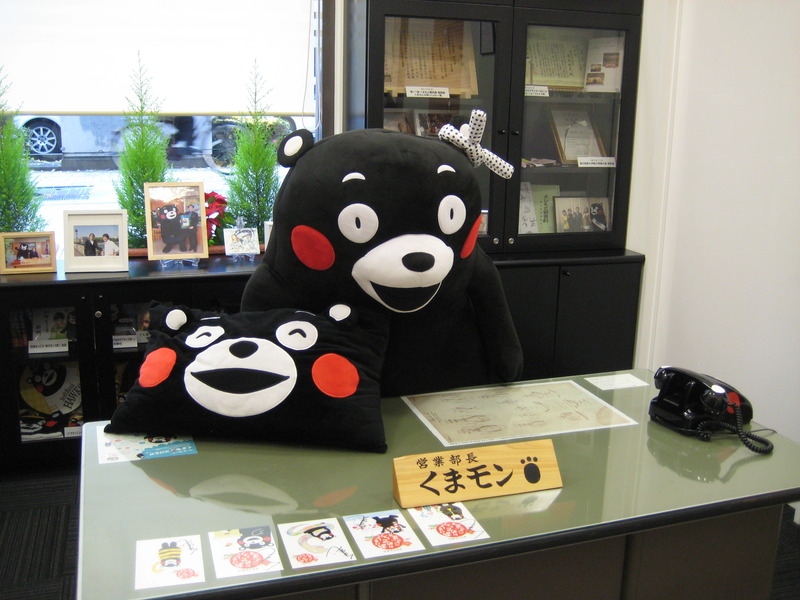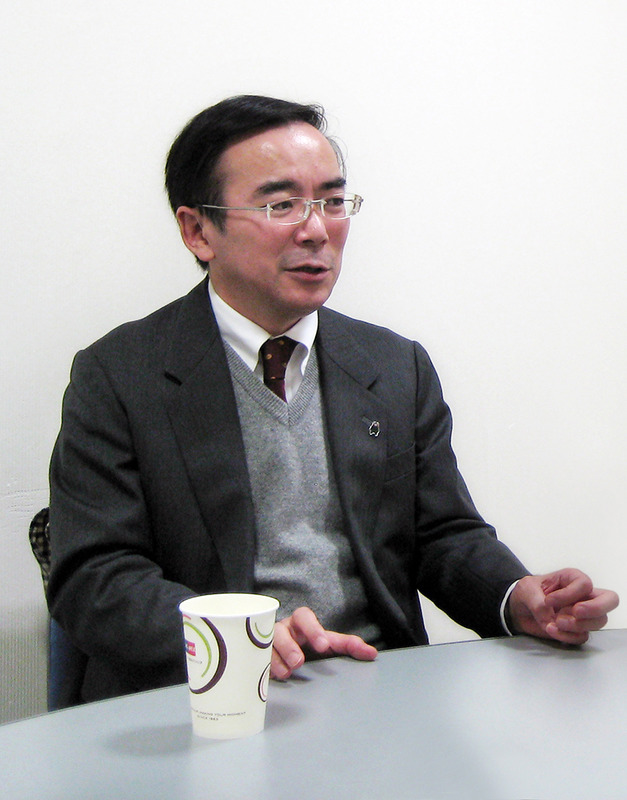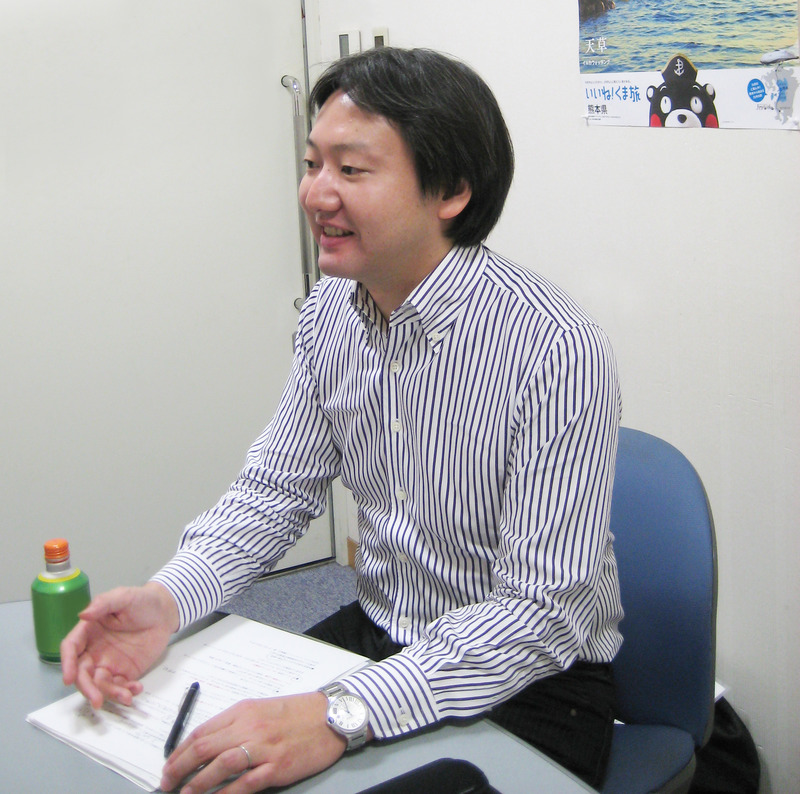Continuing from last time, we spoke with Mr. Masataka Nariō, Manager of Kumamoto Brand Promotion and one of Kumamon's creators, author of "The Secret of Kumamon" (Gentosha Shinsho, 2013), to explore the secrets behind Kumamon's success.

Behind the flashy PR campaigns lies steady sales work
Yamamoto: I get the impression that Kumamon's PR campaigns generated buzz from the very beginning. Collaborations with companies seemed to come together quite smoothly...
Nario: Not at all. We were turned away at the door many times. The first time a company approached us was in late 2010, for the collaboration with Acecook's "Tai Ping Yen." That gave us the idea to "actively go out and pitch," but things didn't go as planned...
Yamamoto: So behind the hits, there was also the groundwork of setting up appointments and steady sales efforts?
Naruo: Yes, our staff made calls every day, and got turned down (laughs). Behind what's now seen as a successful strategy, there were many failures and hardships. The PR campaigns that became major topics, like the ones featured in books, are really just the tip of the iceberg.
Yamamoto: I always thought Kumamon was battle-hardened, so learning that diligent sales work was happening behind the scenes is an important and encouraging story for other characters (laughs).
Nario: When it's not just us wanting to do something, but the companies also find it interesting, and we have a good back-and-forth, that's when things take shape and move in a positive direction. Take the concept car "Kumamon MINI" collaboration with BMW, for example. We built a narrative around Kumamon visiting the Oxford factory in the UK after receiving an invitation from Paddington Bear. This story-driven PR generated significant media exposure. As a thank-you in return, BMW dealers across Japan's 115 locations displayed Kumamoto tourism posters and adopted local products as prizes, creating a highly synergistic campaign.
Yamamoto: To truly spread a character's appeal, everyone involved needs to become fans themselves and genuinely enjoy the process. Talking with you today, Mr. Nariō, I could really feel how much you're enjoying this work.
Naruo: I agree. We started by thinking, "Let's just try it because Kumamon is popular," and the response exceeded both our expectations. That led to a positive cycle where we naturally thought, "Let's collaborate again next time."
Contributing to the Branding of Kumamoto Prefecture Residents
Naruo: The spread of merchandise is incredibly gratifying. However, our primary goal isn't just selling goods; Kumamon's purpose is to promote his hometown, Kumamoto. We operate under the idea that if Kumamoto Prefecture can be promoted alongside the merchandise, that's ideal.
Yamamoto: That's precisely what corporate and organizational mascots should aim for. Moreover, no one can separate Kumamon from Kumamoto; the character and its managing body are firmly linked. It's making a significant contribution to branding Kumamoto Prefecture's residents, isn't it?
Naruo: Absolutely. Not too long ago, if you asked a Kumamoto resident, "Where are you from?" they'd often reply, "Kyushu." But thanks to Kumamon, I feel people now say "I'm from Kumamoto" with pride and confidence. Going forward, we want to create an environment where residents can proudly say, "I'm from Kumamoto, Japan," even overseas.
Fans take charge of quality control
Yamamoto: As the character expands, quality control becomes crucial. How do you approach that?
Naruo: Currently, Kumamon is only officially licensed for domestic distribution in Japan. Even within that, since it's royalty-free, there are quite a few counterfeit or somewhat hastily produced goods circulating. But you know, within Japan, fans actually patrol stores and the internet, find these items, and report them to us in great detail. Things like, "This doesn't have a serial number," or "I found this flyer." We can then take action based on that. It's truly appreciated.
Yamamoto: So you have patrol members? (laughs) That's amazing. Having fans handle quality control like that makes Kumamon a pretty unique character.
Naruo: On the other hand, regarding these counterfeits, within our royalty-free operations, we're torn about whether it's worth using tax money entrusted to us by the citizens to thoroughly eradicate them, considering the cost-effectiveness.
Yamamoto: Especially if we expand overseas, the problems—including countermeasure costs—will only grow larger. And trademark issues vary by country, making it even more complicated...
Naruo: Exactly. As for what we can do now, we need to address the issue upstream. This includes revising agreements with licensees and ensuring overseas manufacturers take responsibility for lot management. Beyond that, the challenge lies in determining how much the prefecture should handle overseas character business know-how and cost burdens.
Yamamoto: But looking at goods circulating domestically, the tone and manner seem consistent, and control appears relatively well-managed.
Naruo: That's true. Fundamentally, Kumamon is an asset owned by the prefecture, and licensing isn't done through top-down directives. I believe domestic business partners genuinely care about Kumamon and cooperate willingly.
Promoting Kumamoto Globally Through Both Local and Overseas Efforts
Yamamoto: Personally, I believe a medium-to-long-term strategy is crucial for corporate or organizational characters. That's because building relationships with consumers doesn't happen overnight. Could you share Kumamon's long-term vision moving forward?
Naruo: Honestly, being asked what we'll do next is the hardest part (laughs). It would be great if we could just do fun things, but we have a mountain of challenges: promoting local products overseas, especially in Asia which will be a key market going forward; attracting tourists; and the trademark issues mentioned earlier... And of course, the most important thing is still within Kumamoto Prefecture itself. For example, steadily visiting places like kindergartens. We'll also collaborate with traditional local crafts like ceramics. That's our core mission.
Yamamoto: So it's about developing both locally and externally, both inward and outward. It wouldn't make sense if only Kumamon's character stood out while Kumamoto Prefecture's own brand power didn't grow. He's not just a character from manga or anime content; we mustn't lose sight of that core purpose.
Naruo: We constantly remind ourselves not to lose sight of that. Selling Kumamon isn't our job. It might sound cold, but Kumamon is merely a hook to sell Kumamoto.
Yamamoto: I often tell companies, "Corporate characters are ultimately solutions to corporate challenges." Hearing you express that understanding, Naruo, really shows why Kumamon functions so effectively.
The fourth year of character development: "Returning to our roots"
Yamamoto: In your book The Secret of Kumamon (Gentosha Shinsho, 2013), you listed five keys to Kumamon's success: "Target audience, TPO (time, place, occasion), SNS (social media), character movement, and top-level understanding and support." About six months after publication, the character has likely grown a bit more. Looking back now, what do you consider most important? Are there any new elements you'd add?
Naruo: I still believe that top-level support has been a major driving force throughout this ongoing journey. It's precisely because Governor Ikuo Kamishima provides solid backing that Kumamon has been able to grow. And recently, I've become more conscious of the element of "surprise." Everyone says it's a success, but honestly, I don't see it as a success yet. While Kumamon is successful in his role as "Kumamoto Prefecture's Sales Director," the economic impact is what gets highlighted, and the original goal of "surprise" has actually been toned down.
Yamamoto: I believe "Kumamoto Surprise" was a campaign that also aimed to boost internal motivation within the prefecture – encouraging residents to rediscover the surprises around them and share them with the outside world!
Naruo: Exactly. While it's fundamentally a spiritual movement for Kumamoto residents, it hasn't fully permeated yet. I believe Kumamon himself consistently embodies surprise as his guiding principle. We're also consciously considering the next steps with this in mind. However, if asked whether "Kumamoto Surprise" is truly rooted among the residents... We need to shift from the current reliance on Kumamon—where people gather just because he comes—toward residents themselves developing a "surprise mindset" to delight visitors. In that sense, after four years, I feel the groundwork is finally taking shape locally. As the flag-bearer for this, Kumamon is more vital than ever.
Yamamoto: When it comes to Kumamon news, everyone listens!
Naruo: For Kumamon's birthday celebration on March 12th this year, we plan to involve the entire central downtown area of Kumamoto City. The prefecture will handle the overall decorations, so we're encouraging everyone to do what they can locally. The message really gets through quickly now. Similarly, I think Kumamoto will only start to become truly interesting when events happen across the prefecture that align with the original campaign concept: where the residents are the main actors providing surprises, and Kumamon assists them.
Yamamoto: If we keep this momentum going, we can expect overseas tourists around the time of the 2020 Tokyo Olympics, right?
Naruo: Last year, when I went to Japan Expo 2013 in Paris, France, I saw Hello Kitty merchandise being sold at a highway service area. That sparked a fire in me—thinking, "Someday, Kumamon too...!" (laughs). If a local government character could become that globally recognized, it would be absolutely fascinating. I believe Kumamon could achieve that. And just as people visiting Tokyo might extend their trip to Kyoto, I want to aim for people to feel like they want to visit Kumamon's hometown too. On the other hand, even if people come to Kumamoto for such an opportunity, it's meaningless if the place isn't interesting enough to make them want to share it with a "Like!" That's why I think Kumamon's true potential is just starting to shine. In that sense, now might be the starting point.
Yamamoto: Mr. Naruo's consistent stance—that Kumamon exists because of Kumamoto and for Kumamoto—was truly inspiring for someone involved in corporate character communication. Thank you very much.










